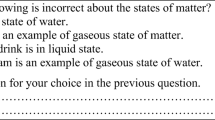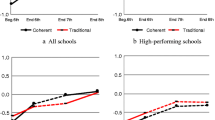Abstract
This study investigated the effect of the Science Writing Heuristic (SWH) approach on grade 9 students’ understanding of chemical change and mixture concepts. Four intact classes taught by two chemistry teachers from a Turkish public high school were selected for the study; one class was assigned as the treatment group, and the other class was assigned as the comparison group. Students in the treatment group were instructed by the SWH approach, while those in the comparison group were instructed with traditionally designed chemistry instruction. Tests measuring students’ conceptual understanding in the units of chemical change and mixture were administered as pre- and posttest for both groups. At the end of the instruction, semistructured interviews were conducted with 13 students from the treatment group and eight students from the comparison group. ANCOVA results revealed that the SWH approach was superior to the traditional approach on students’ understanding of chemical change and mixture concepts. Interview results indicated that students in the treatment group demonstrated better scientific understanding of chemical change and mixture concepts compared to those in the comparison group.

Similar content being viewed by others
References
Abraham, M. R., Williamson, V. M., & Westbrook, S. L. (1994). A cross-age study of the understanding of five chemistry concepts. Journal of Research in Science Teaching, 31(2), 147–165.
Ahtee, M., & Varjola, I. (1998). Students’ understanding of chemical reaction. International Journal of Science Education, 20(3), 305–316.
Akkus, R., Günel, M., & Hand, B. (2007). Comparing an inquiry-based approach known as the science writing heuristic to traditional science teaching practices: are there differences? International Journal of Science Education, 14(5), 1745–1765.
Ardac, D., & Akaygun, S. (2004). Effectiveness of multimedia-based instruction that emphasizes molecular representations on students’ understanding of chemical change. Journal of Research in Science Teaching, 41(4), 317–337.
Ayas, A., & Demirbas, A. (1997). Turkish secondary students’ conceptions of introductory chemistry concepts. Journal of Chemical Education, 74(5), 518–521.
Ayas, A., Özmen, H., & Çalık, M. (2010). Students’ conceptions of the particulate nature of matter at secondary and tertiary level. International Journal of Science and Mathematics Education, 8, 165–184.
Bilgin, İ., & Geban, Ö. (2006). The effect of cooperative learning approach based on conceptual change condition on students’ understanding of chemical equilibrium concepts. Journal of Science Education and Technology, 15(1), 31–46.
BouJaoude, S. B. (1992). The relationship between students’ learning strategies and the change in their misunderstandings during a high school chemistry course. Journal of Research in Science Teaching, 29(1), 687–699.
Burke, K. A., Greenbowe, T. J., & Hand, B. M. (2005, June). Excerpts from The process of using inquiry and the science writing heuristic. Prepared for the Middle Atlantic Discovery Chemistry Program, Moravian College, Bethlehem, PA. Retrieved from http://avogadro.chem.iastate.edu/SWH/Resources.htm
Çalık, M. (2005). A cross-age study of different perspectives in solution chemistry from junior to senior high school. International Journal of Science and Mathematics Education, 3, 671–696.
Çalık, M., Ayas, A., & Coll, R. K. (2007). Enhancing pre-service elementary teachers’ conceptual understanding of solution chemistry with conceptual change text. International Journal of Science and Mathematics Education, 5, 1–28.
Cavagnetto, A. R. (2010). Argument to foster scientific literacy: a review of argument interventions in K-12 science contexts. Review of Educational Research, 80(3), 336–371.
Cohen, J. (1992). A power primer. Psychological Bulletin, 112(1), 155–159.
Coştu, B., Ünal, S., & Ayas, A. (2007). A hands-on activity to promote conceptual change about mixtures and chemical compounds. Journal of Baltic Science Education, 6(1), 35–46.
Coştu, B., Ayas, A., & Niaz, M. (2010). Promoting conceptual change in first year students’ understanding of evaporation. Chemistry Education Research and Practice, 11, 5–16.
Davis, J. (2001). Conceptual change. In M. Orey (Ed.), Emerging perspectives on learning, teaching, and technology. Retrieved from http://projects.coe.uga.edu/epltt
Driver, R., Guesne, E., & Tiberghien, A. (1985). Children’s ideas in science. Philadelphia: Open University Press.
Duit, R. (2007). Science education research internationally: conceptions, research methods, domains of research. Eurasia Journal of Mathematics, Science & Technology Education, 3(1), 3–15.
Ebenezer, J. V. (1992). Making chemistry learning more meaningful. Journal of Chemical Education, 69(6), 464–467.
Eilks, I., Moellering, J., & Valanides, N. (2007). Seventh-grade students’ understanding of chemical reactions: reflections from an action research interview study. Eurasia Journal of Mathematics, Science & Technology Education, 3(4), 271–286.
Erkol, E., Günel, M., Kışoglu, M., Buyukkasap, E., & Hand, B. (2008, March–April). Impact of the science writing heuristic as a tool for learning in introductory physics laboratory. Paper presented at the Annual Meeting of the National Association for Research on Science Teaching, Baltimore.
Gabel, D. (1999). Improving teaching and learning through chemistry education research: a look to the future. Journal of Chemical Education, 76(4), 548–554.
Garnett, P. J., Garnett, P. J., & Hackling, M. W. (1995). Students’ alternative conceptions in chemistry: a review of research and implications for teaching and learning. Studies in Science Education, 25, 69–95.
Gooding, C. T., Swift, J. N., Schell, R. E., Swift, P. R., & McCroskery, J. H. (1990). A causal analysis relating previous achievement, attitudes, discourse, and intervention to achievement in biology and chemistry. Journal of Research in Science Teaching, 27(8), 789–801.
Günel, M., Kabataş-Memiş, E., & Büyükkasap, E. (2010). Effects of the science writing heuristic approach on primary school students’ science achievement and attitude toward science course. Education and Science, 35(155), 49–62.
Hand, B., Norton-Meier, L., Staker, J., & Bintz, J. (2009). Negotiating science: The critical role of argument in student inquiry, grades 5–10. Portsmouth: Heinemann.
Johnson, P. (2000). The development of children’s concept of a substance: a longitudinal study of interaction between curriculum and learning. Research in Science Education, 35, 41–61.
Jones, L. S., & Beeth, M. E. (1995, April). Implementing conceptual change instruction: A case study of one teacher’s experience. Paper presented at the Annual Meeting of the National Association for Research in Science Teaching, San Francisco.
Kabatas, E., Günel, M., Büyükkasap, E., Uzoğlu, M., & Hand, B. (2008, March–April). Effects of the implementation of science writing heuristic on students’ understanding of electricity unit in 6th grade setting in Turkey. Paper presented at the Annual Meeting of the National Association for Research on Science Teaching, Baltimore.
Keys, C. W., Hand, B., Prain, V., & Collins, S. (1999). Using the science writing heuristic as a tool for learning from laboratory investigations in secondary science. Journal of Research in Science Teaching, 36(10), 1065–1084.
Marshall, C., & Rossman, G. B. (2006). Designing qualitative research (4th ed.). Thousand Oaks: Sage.
Ministry of National Education. (2007). 9th grade high school chemistry curriculum. Ankara: Author.
Nakhleh, M. B. (1992). Why some students don’t learn chemistry. Journal of Chemical Education, 69(3), 191–196.
Nam, J., Choi, A., & Hand, B. (2010). Implementation of the science writing heuristic (SWH) approach in 8th grade science classrooms. International Journal of Science and Mathematics Education, 9(5), 1111–1133.
Papageorgiou, G., & Sakka, D. (2000). Primary school teachers’ views on fundamental chemical concepts. Chemistry Education: Research and Practice in Europe, 1(2), 237–247.
Pınarbaşı, T., Canpolat, N., Bayrakçeken, S., & Geban, Ö. (2006). An investigation of effectiveness of conceptual change text-oriented instruction on students’ understanding of solution concepts. Research in Science Education, 36, 313–335.
Pintrich, P. R., Marx, R. W., & Boyle, R. A. (1993). Beyond cold conceptual change: the role of motivational beliefs and classroom contextual factors in the process of conceptual change. Review of Educational Research, 63(2), 167–199.
Posner, G. J., Strike, K. A., Hewson, P. W., & Gertzog, W. A. (1982). Accommodation of a scientific conception: toward a theory of conceptual change. Science Education, 66(2), 211–227.
Rudd, J. A., Greenbowe, T. J., & Hand, B. M. (2007). Using the science writing heuristic to improve students’ understanding of general equilibrium. Journal of Chemical Education, 84(12), 2007–2011.
Salta, K., & Tzougraki, C. (2011). Conceptual versus algorithmic problem-solving: focusing on problems dealing with conservation of matter in chemistry. Research in Science Education, 41, 587–609.
Sanger, M. J. (2000). Using particulate drawings to determine and improve students’ conceptions of pure substances and mixtures. Journal of Chemical Education, 77(6), 762–766.
Schroeder, J. D., & Greenbowe, T. J. (2008). Implementing POGIL in the lecture and the science writing heuristic in the laboratory—student perceptions and performance in undergraduate organic chemistry. Chemistry Education Research and Practice, 9, 149–156.
Solsona, N., Izquierdo, M., & de Jong, O. (2003). Exploring the development of students’ conceptual profiles of chemical change. International Journal of Science Education, 25(1), 3–12.
Stains, M., & Talanquer, V. (2007). Classification of chemical substances using particulate representations of matter: an analysis of student thinking. International Journal of Science Education, 29(5), 643–661.
Stavridou, H., & Solomonidou, C. (1998). Conceptual reorganization and the construction of the chemical reaction concept during secondary education. International Journal of Science Education, 20(2), 205–221.
Author information
Authors and Affiliations
Corresponding author
Rights and permissions
About this article
Cite this article
Kingir, S., Geban, O. & Gunel, M. Using the Science Writing Heuristic Approach to Enhance Student Understanding in Chemical Change and Mixture. Res Sci Educ 43, 1645–1663 (2013). https://doi.org/10.1007/s11165-012-9326-x
Published:
Issue Date:
DOI: https://doi.org/10.1007/s11165-012-9326-x




